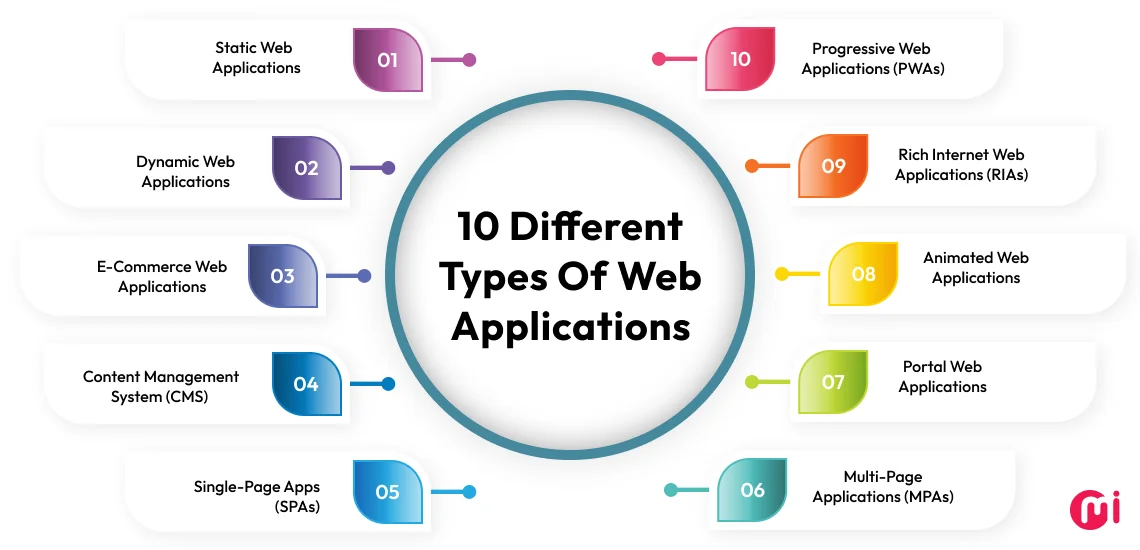Choosing the right type of web app for your needs can be challenging, especially with so many options available. However, the good news is that each type of web application is tailored to specific business requirements—such as CMS for blogging platforms, multi-page apps for enterprise solutions, and web portals for students or clients. In this blog post, we outline the top ten types of web applications, detailing their pros, cons, and key features to help you make an informed decision for your business.
Take Trello, Canva, Airbnb, Spotify, Netflix, and Basecamp, regardless of the industry these businesses belong to or the services they offer their customers. There is one thing that is common when it comes to their growth: they all have a web app.
These web apps drive active users, higher conversions, user engagement, user retention, and brand awareness, along with contributing to substantial revenue growth for these businesses.
Apart from offering services like these businesses do, web apps are also becoming an integral part of the digital transformation strategies for most companies. Whether it’s improving internal operations by developing a web app like Slack or offering customer-facing apps like the ones banks provide to their consumers, web apps are playing an increasingly significant role.
So, whether it’s through improving internal workflows, offering personalized services, or expanding market reach, web apps are playing a key role in the evolution of businesses across various industries.
Once you decide to have a web app, the next course of action would be to determine which type of web app to choose. Whether to go for a single-page application, a multi-page application, or a progressive web app.
To make an informed decision regarding the most suitable web app for your requirements, it is essential to understand these types in detail.
Read on to discover ten different types of web applications in detail.


10 Different Types of Web Applications
From simplifying everyday tasks to enhancing operational efficiency and customer experiences, the right type of web app can significantly impact your business’s success. Here are ten types of web applications that you can explore to choose the right one for your business needs:


1. Static Web Applications
Static web apps are the simplest types of web apps that deliver content to the user without dynamic or real-time data processing from the server. These apps offer straightforward, cost-effective solutions for businesses that need a simple online presence with minimal interactivity.
| Pros of Static Web Application: | Cons of Static Web Application: |
| Load extremely fast, offering a seamless user experience | Lack of dynamic features such as user login and real-time data processing |
| Less expensive to develop and host | Content updates are time-consuming as they are manual |
| Less vulnerable to certain types of cyberattacks like SQL injections or data breaches | Offer limited features and functionalities |
These types of web apps are ideal for businesses that don’t require frequent content updates or complex interactions.
2. Dynamic Web Applications
Dynamic Web Applications (DWAs) are web applications that offer interactive and real-time user experiences by generating content on the fly based on user inputs or other data. Unlike static web applications, which display fixed content, dynamic web apps fetch data from a database or server and update content dynamically, providing users with a highly personalized and engaging experience.
| Pros of Dynamic Web Application: |
Cons of Dynamic Web Application: |
| Offer personalized content and interactions | Higher development cost |
| Deliver personalized experiences | – |
| Enable scalability | – |
| Easy content updation and modification | – |
Some of the most popular web apps, like Netflix, YouTube, and Facebook, are dynamic web apps.
Now that you have chosen the best fit from the different types of web applications, you can explore our guide on How to Build a Web App from Scratch to understand the steps involved in web app development and more.
3. E-Commerce Web Applications
E-commerce web apps are platforms that allow businesses to buy and sell their products or services online. These apps are one of the popular digital transformation strategies in omnichannel retail for most eCommerce businesses. Once developed, they serve as the backbone of a retailer’s online operations, providing 24/7 access to a global customer base.
In terms of market figures, the global e-commerce platform market size was valued at USD 8.7 billion in 2023 and is expected to grow at a CAGR of 13.5% during the forecast period of 2024 to 2032.
| Pros of eCommerce web apps: | Cons of eCommerce web apps: |
| Provide global reach and increased product sale | Consistent maintenance is required |
| Provide detailed customer and sales analytics via data insights | – |
| Easy business scalability | – |
Some eCommerce web apps generating billions in revenue include Amazon, eBay, Etsy, and others.
If you are an e-commerce business operating under models such as B2B, B2C, B2B2C, D2C, or C2C and are planning to expand your market reach, eCommerce app development is a viable option for your business. In a nutshell, if you want to develop a marketplace like Amazon, this would be your ideal choice.
4. Content Management System (CMS)
A CMS is a web application that allows your teams to effortlessly manage digital content. It facilitates easy creation, editing/modification, organization, and publishing of content without requiring assistance from technical teams or specialized knowledge.
It is also one of the most highly demanded software solutions for efficient content management worldwide, as market statistics show. The CMS market is estimated to reach US$28.00 billion by 2029, exhibiting an annual growth rate (CAGR) of 4.90% during the 2024-2029 period. It is expected to reach US$22.04 billion by 2024.
| Pros of CMS: | Cons of CMS: |
| Availability of customization options | Require frequent security updates |
| Simplifies collaboration among users | – |
| User-friendly and mobile-friendly | Possibility of hidden costs of plugins, themes, etc |
| Anytime, anywhere access | Overdependence on plugins |
| Offers detailed analytics | – |
| Development is cost- and time-effective | Potential threat of hacking from outdated plugins |
If you are looking for better content governance, improved information architecture for content categorization and tagging, automated or collaborative workflows, an engaging user experience, optimal security, and more, a CMS is the right choice for your business.
Joomla, Drupal, WordPress, and Wix are among the most popular content management systems.
5. Single-Page Applications(SPAs)
As the name suggests, SPAs are single-page web apps in which the content loads and updates dynamically without reloading of the entire page. Unlike traditional multi-page websites, SPAs load a single HTML page and dynamically update content as the user interacts with the app. These apps are designed to minimize the delays in content delivery.
| Pros of SPAs: | Cons of SPAs: |
| Reduced page reloads offer a responsive user experience | Slower internet connections can lead to slower initial load times |
| Client-side rendering reduces the workload on servers | Client-side resource usage intensity may impact performance on older devices |
| Improved app performance due to loading only the necessary components | With just a single page, SEO can be challenging |
| Facilitates easy scalability | – |
SPAs are ideal for apps that require real-time data processing, instant feedback, or frequent user interactions. Additionally, they are often chosen by businesses that heavily rely on storing and manipulating large amounts of data.
Simply put, if you want to develop an app like Airbnb, Netflix, Pinterest, PayPal, or similar, a Single-Page Application (SPA) is the best type of web application for your business.
6. Multi-Page Applications (MPAs)
MPAs, an abbreviation for Multi-Page Applications, are web apps where each user interaction or request loads a new page from the server. Unlike SPAs, the entire page reloads to update the content. This means that, unlike SPAs, where a single page serves multiple purposes, MPAs have separate pages dedicated to different purposes.
Some of the best examples of Multi-Page Applications include Amazon, eBay, Twitter, and more.
| Pros of MPAs: | Cons of MPAs: |
| Easy implementation of security measures | Can be slower than SPAs in delivering dynamic content |
| Faster initial load time compared to SPAs | Higher server load due to an increased number of requests |
| Easier to optimize for search engines | – |
| Simpler to develop than SPAs | – |
| Easier to scale the web application | – |
MPAs are ideal if your app idea is content-intensive (e.g., e-commerce platforms, enterprise solutions) and requires diverse features or complex user interactions.
7. Portal Web Applications
Portal web apps, also known as web portals, are web-based platforms that provide users with access to information aggregated from various sources. These portals are widely used across industries and cater to diverse user requirements, such as educational portals, patient portals, and client/customer-facing portals. They are designed to deliver personalized content to users based on their specific needs.
Access to these portals is typically secured through authentication, ensuring that only authorized users can view the aggregated information or resources.
| Pros of Portal Web Applications: | Cons of Portal Web Applications: |
| Provide personalized experiences for users | May experience authentication challenges |
| Offer scalability to accommodate growing content and user roles | Require a significant upfront investment for development and deployment |
| Enhance operational efficiency with inbuilt tools | Demand regular updates and maintenance |
The use cases of portal web apps include the Stanford University Portal, SharePoint, Google, and more.
8. Animated Web Applications
Animated web apps enable you to integrate engaging animations and dynamic visual elements to enhance user engagement and interactivity. Built using web technologies like HTML5, CSS3, and JavaScript libraries, animated web apps deliver smooth transitions, interactive elements, and engaging storytelling, making them more immersive and visually appealing for users.
| Pros of Animated Web Applications: | Cons of Animated Web Applications: |
| Improved user engagementSmoother navigation and interactivity | Animation may slow down performance |
| Stronger brand impact | High development costs |
A few web apps by Google that best illustrate this type include Game of the Year, Your Plan Your Plane, and others.
9. Rich Internet Web Applications (RIAs)
Rich Internet Applications (RIAs) are web applications that provide a more interactive and dynamic user experience, similar to desktop applications but accessible through a web browser. Unlike traditional web apps, which rely on basic HTML and server-side rendering, RIAs deliver a richer user interface (UI) by leveraging advanced client-side technologies like JavaScript, HTML5, and AJAX.
| Pros of Rich Internet Web Applications: | Cons of Rich Internet Web Applications: |
| Enhanced interactivity and fast response times | May not perform optimally on older browser versions |
| Ideal for applications that require real-time updates | If not properly secured, they may create security vulnerabilities |
| Facilitates consistency in appearance and functionality across different browsers | – |
| Can be used offline | – |
| May offer better performance than native apps, depending on network conditions | – |
Google Docs, Gmail, and YouTube are some examples of rich Internet applications.
10. Progressive Web Applications (PWAs)
PWAs are web apps that offer a user experience similar to native mobile and desktop apps. These apps are built using web technologies and can run on multiple platforms and devices using a single source code.
One often standout feature of PWA is their ability to be downloaded directly onto mobile devices without requiring an app store. This broadens your target audience, expanding the reach to nearly 6.3 billion mobile users.
In addition to their accessibility, PWAs are known for their exceptional performance. Opting for progressive web app development has the potential to increase user engagement by up to 180%.
Last but not least, the market potential for PWAs is enormous. The market is estimated to grow at a CAGR of 26% during the forecast period of 2024 and 2032. The market size when last valued in 2023 was USD 1.3 billion.
| Pros of PWAs: | Cons of PWAs: |
| App store-independent | Compatible only with devices running iOS 13 and later |
| Native-like experience at a much lower development cost | Incompatible with mobile devices using outdated web browsers |
| Smaller in size than mobile apps | May not perform all functions that native mobile apps can |
| Operates effectively even with limited connectivity or offline | Limited access to device features (Touch ID, Face ID, beacons, etc., on Apple devices) |
| Runs on any device with a web browser, hence offering cross-platform compatibility | – |
| Better performance than traditional web apps | – |
| No manual action is required from users to update PWA | – |
| Can utilize platform-specific features such as push notifications | – |
| Can be indexed by search engines, hence SEO friendly | – |
Some of the popular PWAs are Uber, Starbucks, Tinder, Pinterest, and more.
Also Read: A Detailed Guide on Progressive Web Apps


Web App Development Made Easy With MindInventory
We are a leading web app development company with an experienced team of experts offering end-to-end web app development services. Whether you are planning for MEAN stack web app development, MERN stack web app development, FastAPI development, Laravel development, Django app development, and more, we have you covered.
You can hire dedicated developers from us with expertise in MERN stack, MEAN stack, MEVN stack, LAMP stack, JAM stack, Flask stack, Django stack, and more.
Our portfolio includes Snug, a home rental platform. As part of our deliverables, we built the backend using Golang and PostgreSQL and created an admin panel for managing property viewing.
Another project in our portfolio is an e-learning and Edu-Fintech platform for a renowned education finance company. We also developed an Edu-Fintech platform featuring skill assessments and course recommendations. The app, with over 55 top university partnerships, competes with industry leaders like Coursera and Udemy.
If you are also looking to outsource your web app development with expertise and experience in your industry, contact our team today. Let’s discuss how we can help you achieve your business goals.
FAQs on Web Application Development
Web applications are types of apps that can be used by accessing them via a web browser. When accessed from the web browser on a mobile device or desktop, these apps provide a user experience similar to a native app without the need for installation.
Choosing the right type of web app for your business depends on several factors, including user experience requirements, available technical resources, development budget, existing IT infrastructure, scalability needs, UX considerations (such as interactivity and ease of navigation), functional requirements (such as offline capabilities and device features like GPS or camera), and integration requirements (with existing CRMs, ERPs, or analytics tools).
Commonly used programming languages for web app development include JavaScript, TypeScript, Python, PHP, Go, C#, HTML, CSS, Swift, Kotlin, Ruby, and more.













Leave a Reply